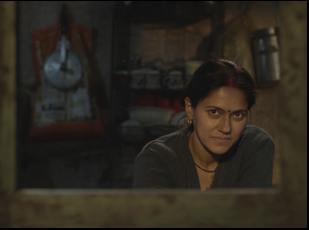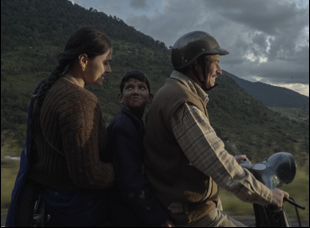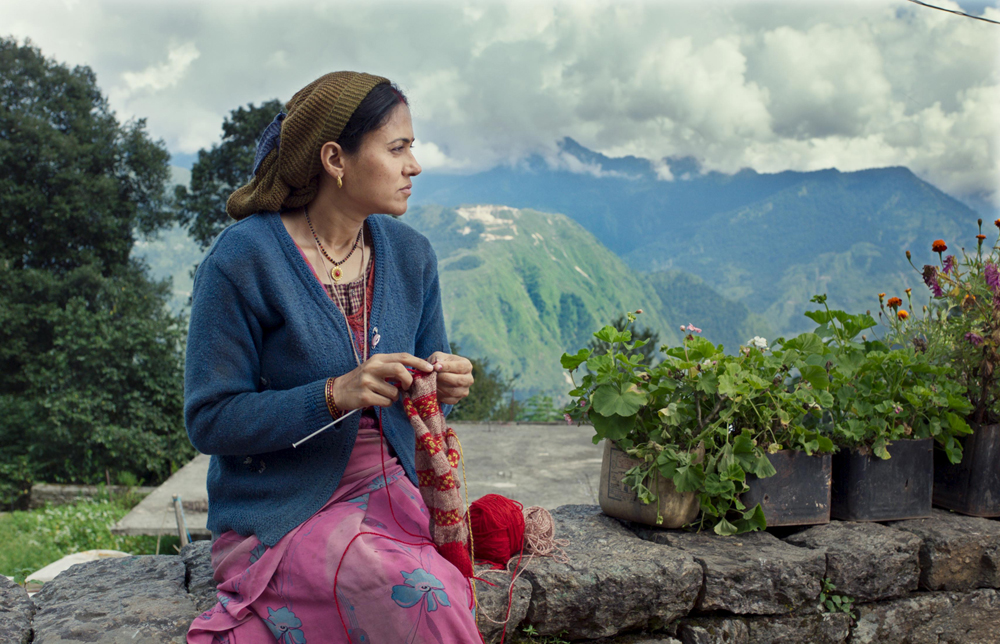When Ajitpal Singh learned of his cousin’s death in 2018, he wondered why. It wasn’t for availability of medical care, but rather her husband’s willingness to take her to the hospital in the first place when the predominant thought in the area of rural India in which she lived ascribed the cause of her illness to the supernatural. Sadness was accompanied by fierce sense of curiosity about how this could happen, a question that led him into the Himalayas where he would ultimately film “Fire in the Mountains,” which tells of a family that would seem to be positioning themselves for the future while being frustrated by how their patriarch Dharam (Chandan Bisht) is beholden to the past.
It is evident from the opening frames of Singh’s feature debut that Chandra (Vinamrata Rai) is the one in the marriage who likes to take charge, beating back the competition on the low ground to invite recently arrived tourists to stay with the family to supplement the dwindling income from their farm. Things are dire enough that Dharam is angered by the use of chicken in a batch of curry for the visitors when there is little the family can spare and while Chandra busies herself with trying to improve the family’s standing, whether through renting out their humble home with its extraordinary view or attempting to create a more accessible path through town for their handicapped son Prakash (Mayank Singh Jaira), Dharam is pulled into thinking they are living under a curse, consulting a local guru and becoming increasingly agitated at any alternative points of view.
In spite of taking place in one of the world’s most remote locations, “Fire in the Mountains” becomes instantly familiar in these politically polarized times as Dharam can only embrace what he knows out of fear of what the future holds and his family — a close, loving clan including teenage daughter Kanchan (Harshita Tiwari) and his sister Kamla (Sonal Jha) — appear to be on a road towards implosion when they’re headed in different directions. Still, the drama is set apart by the regional authenticity Singh is able to bring to the screen – beyond the breathtaking scenery, the difficulties of navigating the physical obstacles imposed by living at such high elevation is often surpassed by the outdated traditions that even Dharam has issues abiding by and the director is able to illuminate the mounting frustrations that pollute one person’s mind before entering the stream of an entire culture. With the film returning to America after a celebrated festival run that began last year with the virtual edition of Sundance in 2021 finally in theaters, Singh spoke about how he battled the elements as well as the limits of his own personal perspective to make “Fire in the Mountains” such a moving drama.

The idea was initially I grew up in a village as a boy and some of the experience that the boy had – not all, but some I have had I too and initially I wrote it from his point of view. But after seven or eight months, I had a break from [writing] the story. I didn’t read it, I didn’t think much about it and I read it again and I realized that “No, this is Chandra’s story, she’s the strongest character out there,” and then I started to think what if I turn it towards Chandra’s point of view. Then I was really excited. It just became so much easier to feel things because she’s the one who’s really going through the struggle.
Did the story evolve as you spent time in the mountains where this takes place?
That was the best part. You must’ve read this [book] by Andrei Tarkovsky called “Sculpting in Time,” and I think in a similar way, you can do sculpting with reality, like you go and you sit down for hours and you observe the life, the pace, the real incidents and then you change them, you add drama into it. For example, that entire leopard scene [in the film] actually happened in front of my eyes in the village. A leopard came and took a dog away, and there were so many things which I noticed when I was there for five months. I brought the scene around those moments, so that’s something I do with all the story that’s not easy where you get lost because you do the research and you [get] these many, many moments from there and they don’t have a connection, but they are so beautiful and they represent that milieu, that geography, that culture. You want them to become part of your story, but then you have to weave a story in a way where you include them and that’s where it takes so much longer.
What was it like to bring this cast together as a family?
Vinamrata, who plays Chandra, I had worked with on a short film and she is not from the village. She grew up in Delhi, but I knew that she had that burning passion to act again and she’s very talented, but she hasn’t gotten her due, so it was very easy to cast her. Chandan from Drakan, the mountain and he’s a trained actor from a very well-known school of drama, and I knew he’d go against the character, so that felt really important. Sonal [Jha] I had also worked with and I knew she would do well, but for the other casting, my casting director Taran Bajaj traveled to small, small villages where he would put on [auditions] at the schools and in the villages and he spent almost two to three months to scout for these real people, many of them who had never acted before. And then the cast stayed together for 10 days before the shooting where they actually became a family. Like the boy really started sleeping [in the same bed as Vinamrata, who played] the mother.

Yes, I had worked on four short films by the time I had made “Fire in the Mountains” and every time, I struggled with the costume. because aging [clothes] looks fine, but it’s not full of details like when you wear a shirt for a very long time. The color falls differently, a shape forms here, a hole around the button gets bigger. When clothes [naturally] age, they fall very differently on your body, so I wanted to have that authentic feeling of clothes that are not new clothes. So my costume designer and I came up with the plan, “What if we buy new clothes and give the new clothes to people who would give us their old clothes?” And most of the clothes we found were very old, but one of the jackets that Dharam has, that’s probably a 25-year-old jacket that this [local] man had been wearing for 25 years and didn’t want to give it to us. [laughs] But my costume designer kept pursuing [him] — she bought him a nice jacket that he really liked and we got that jacket.
What was it like shooting in the mountains? Was taking equipment up a challenge?
On the first day of the shoot, our truck with the light was coming and we heard the road ahead of the truck has gone in a landslide. The truck tried to go back to take another route and then the landslide happened and the road behind the truck was also gone, so literally our truck was standing on an island. It could not go ahead, it could not go back, so for the first day, we shot without lights and without mics. We didn’t have battery for the equipment and we didn’t have lights. Then the second day, our cinematographer Dominique [Colin] had some tooth problem and there were no dentists in the town, so he had to take a taxi, which is like seven hours one way to drive to the city and get treated and he came back. But we still shot with the assistant cinematographer without the light and sound.
When that’s in the first few days of filming, does it give you confidence you can pull off anything after?
That was the beauty because by that time my entire crew had spent almost 10 days together and we were total only 35 people, so we had already bonded so much. That was the best part of shooting in this small place where there are no bars, no cafes, nothing actually. We just spent time together and you cook together and you eat together and you drink together. We never really had a hectic time, but almost every week either I was cooking for the whole crew or our dialogue writer or our lead actress was cooking for the whole crew, so it was really fun. Actually, when I’m talking about it, I want to go back and do another film like “Fire in the Mountain.”
“Fire in the Mountains” opens on May 20th in New York at Film Forum and on May 27th in Los Angeles at the Laemmle Royal, the Encino Town Center 5 and the Pasadena Playhouse 7.




